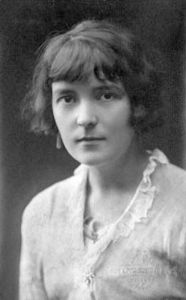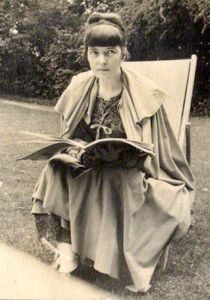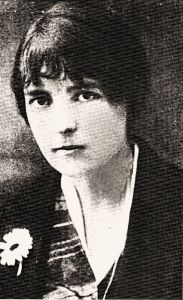New Zealand writer
 Born on 14 October 1888 into a wealthy family in Wellington, New Zealand, and first cousin of Elizabeth von Arnim, she published her first short stories in the local high school newspaper between 1898 and 1899.
Born on 14 October 1888 into a wealthy family in Wellington, New Zealand, and first cousin of Elizabeth von Arnim, she published her first short stories in the local high school newspaper between 1898 and 1899.
She moved to London in 1902 where she attended Queen's College.
A talented cellist, she was initially not very attracted to literature.
Mansfield is best known as an author of short stories, which she began to write between 1906 and 1908.
In London she led a rather unruly life, becoming romantically involved with at least two women, Maata Mahupuku and Edith Kathleen Bendall.
In 1909, after a hasty and unconsummated marriage to George Bowden, a singing teacher, she was sent by her mother to the Bad Wörishofen spa in Bavaria. Following these events, she was disinherited by her mother, Annie Beauchamp. During her stay in Bavaria, however, she read for the first time Anton Chekhov, a writer who was to have a significant impact on her.
In 1911, Katherine published her first collection of short stories, "In a German Pension" (which she later described as "immature") and came into contact with contemporary writers such as David Herbert Lawrence and Virginia Woolf, and Lady Ottoline Morrell, a patron close to the Bloomsbury Group. Also in 1911, she met the critic John Middleton Murry, whom she married in 1918 (although after the war she had an affair with the journalist Beatrice Hastings), the same year that 'Prelude' was published by Hogarth Press.
After contracting tuberculosis in 1917, he began to spend the winters abroad, mainly in France and Italy (San Remo), without particularly benefiting from it.
From 1919 onwards, her production was enriched by a large number of reviews, commissioned by her husband Murry, who had meanwhile become editor of the Athenaeum magazine.
Two collections of short stories established her as one of the most original voices of modernism, Bliss (1920) and The Garden Party (1922). The writer spent the last years of her life searching for a cure for tuberculosis, consulting the most unorthodox doctors, such as Ivan Manoukhin, before going to Georges Gurdjieff's Institute for the Harmonious Development of Man in Fontainebleau, France, in October 1922, where she underwent extreme trials and where she died following yet another haemorrhage on 9 January 1923. She was buried in the nearby Avon Cemetery.
The writer spent the last years of her life searching for a cure for tuberculosis, consulting the most unorthodox doctors, such as Ivan Manoukhin, before going to Georges Gurdjieff's Institute for the Harmonious Development of Man in Fontainebleau, France, in October 1922, where she underwent extreme trials and where she died following yet another haemorrhage on 9 January 1923. She was buried in the nearby Avon Cemetery.
On her death, Katherine left a large number of unpublished prose pieces published by Murry, her literary executor, in later years, including "The Dove's Nest" (1923), and editions of her letters and diary. In July 2012, four short stories included in the latest edition of "Tutti i racconti "(2013) by Mondadori were found at King's College, London. Katherine Mansfield's stay in San Remo and the Riviera in the autumn and winter of 1919 is one of the final moments in the human life of this great 20th-century writer. The young Katherine had come to San Remo to spend the winter in the warm, sunny climate that should have helped her illness, consumption, which had been revealed a few years earlier.
Katherine Mansfield's stay in San Remo and the Riviera in the autumn and winter of 1919 is one of the final moments in the human life of this great 20th-century writer. The young Katherine had come to San Remo to spend the winter in the warm, sunny climate that should have helped her illness, consumption, which had been revealed a few years earlier.
After numerous trips that had taken her to England, Germany and France, her stay in San Remo began under good auspices: cheerful and optimistic, Mansfield had been struck by the «gloomy» antique shops from whose windows she glimpsed «magnificent things» that her finances did not allow her to buy but which attracted her with their «gleam of silver and copper».
She notices the «dark women» carrying chrysanthemums to market; «and the whole city full of beautiful flowers». The elegant streets, the well-kept shops, the bright sky and the lush gardens give her hope of recovery and of a future where it is still possible to realise her life plan.
She enthusiastically tells her husband about it in a letter. From her room at the Pensione Excelsior in Sanremo and then from the "Casetta" in Ospedaletti, she fought the illness by reading and listening to music. But above all she wrote. Sadder, rainier and windier days soon followed which, together with the symptoms of consumption and loneliness, caused her to relapse into depression, which led to her death at Fontainbleau.
(source: Wikipedia with added notes from the book "Sanremo e l'Europa, l'Immagine della Città tra Otto e Novecento" edited by Letizia Lodi; ediz. Scalpendi, 2018)




